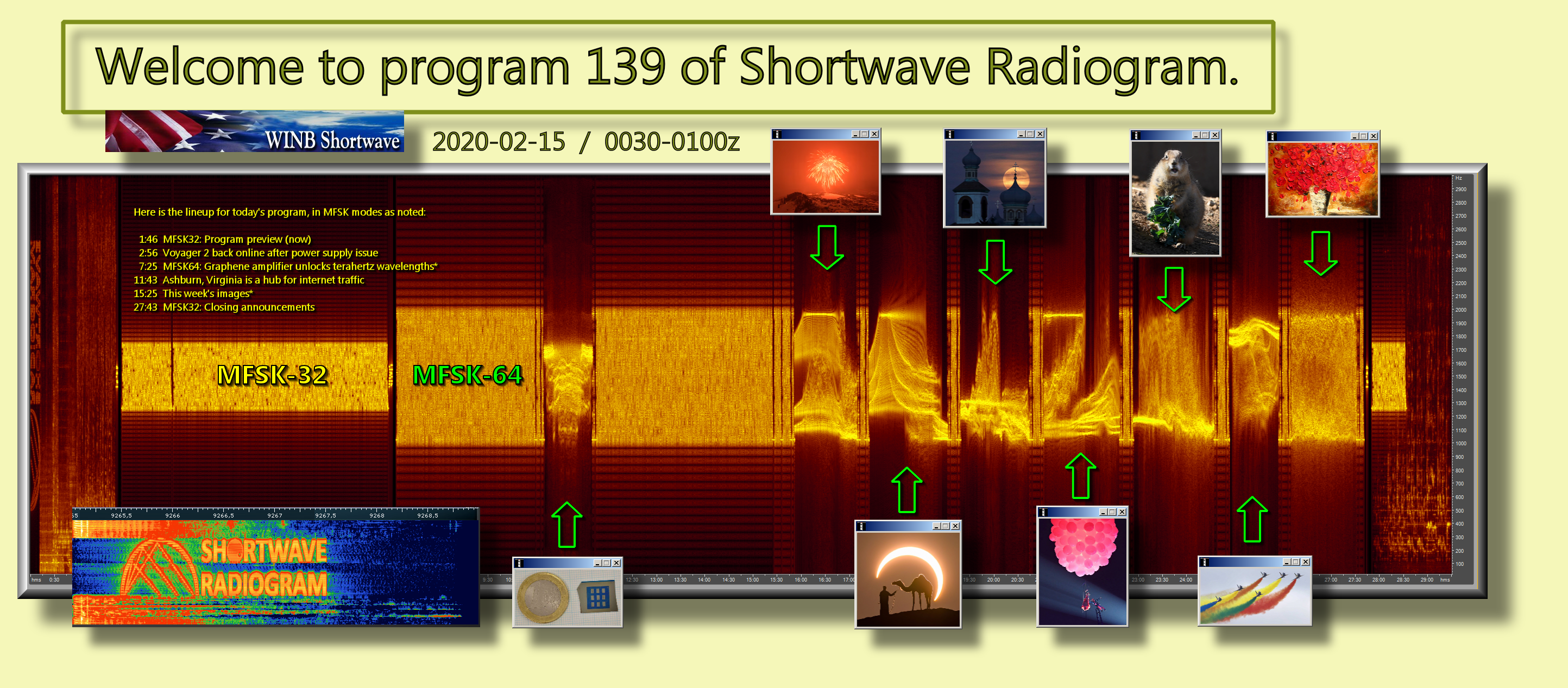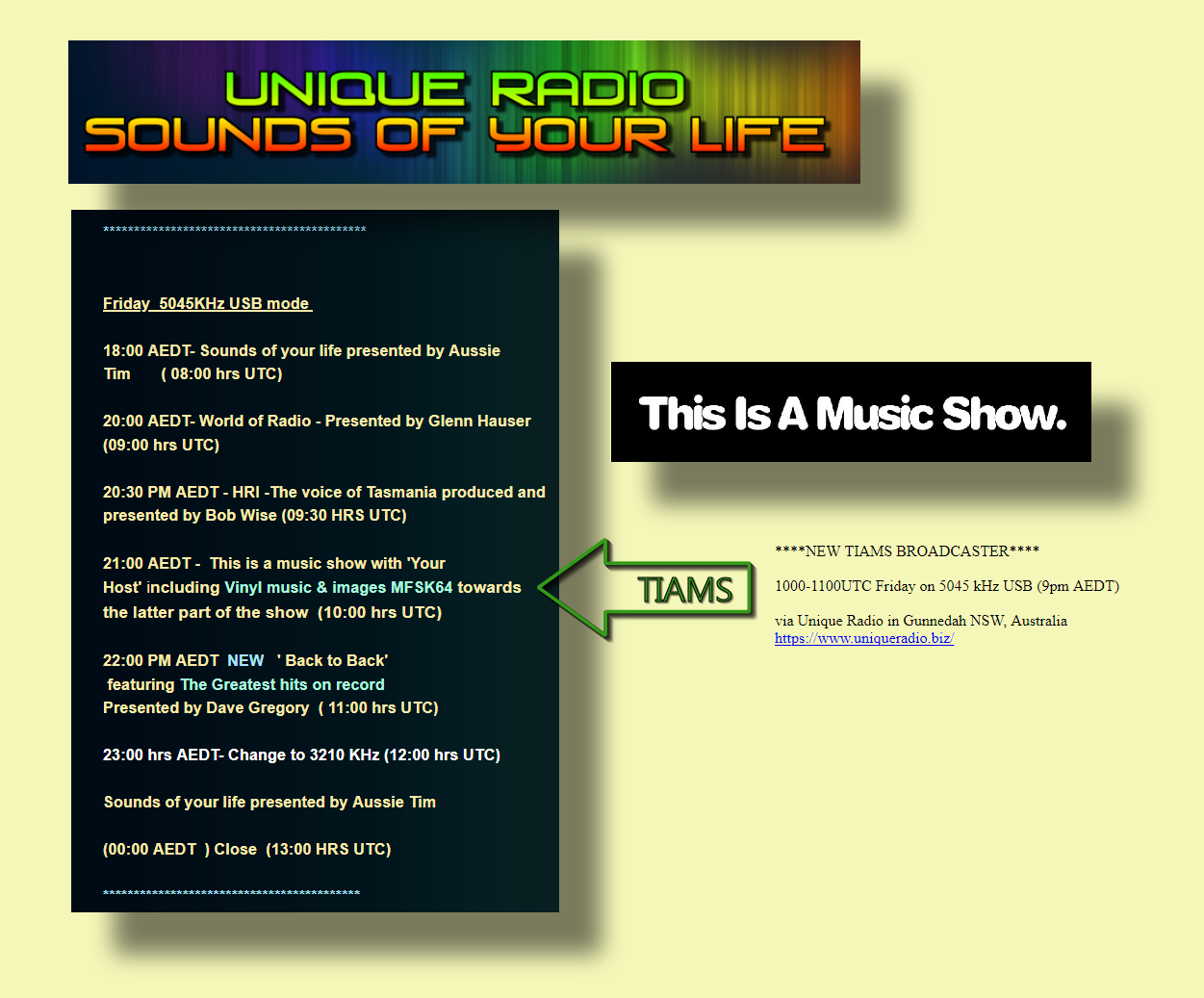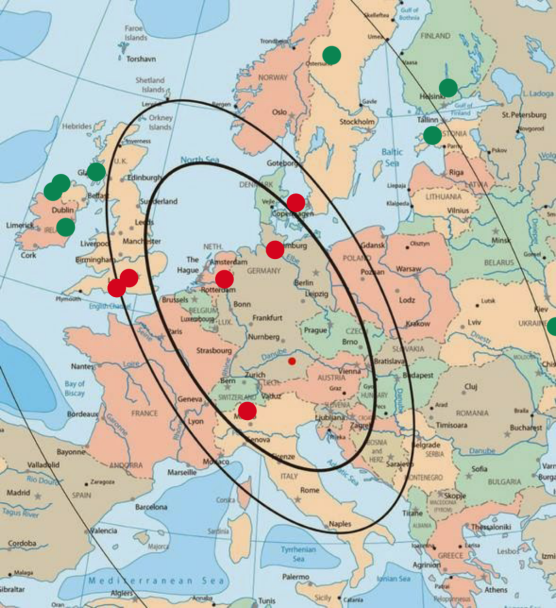http://www.rhci-online.net/radiogram/radiogram.htm

RSID: <<2020-02-16T01:30Z
MFSK-64
@ 5960000+1500>>
Salvatore Phillip "Sonny" Bono was born February 16, 1935.
He died in 1998.
Sending Pic:181x228;

en.wikipedia.org/wiki/Sonny_Bono
Please report decode to
themightykbc@gmail.com


RSID: <<2020-02-14T00:31Z
MFSK-32 @
9265000+1500>>
Welcome to program 139 of Shortwave Radiogram.
I'm Kim Andrew Elliott in Arlington, Virginia USA.
Here is the lineup for today's program, in MFSK modes as noted:
1:46 MFSK32: Program preview (now)
2:56 Voyager 2 back online after power supply issue
7:25 MFSK64: Graphene amplifier unlocks terahertz wavelengths*
11:43 Ashburn, Virginia is a hub for internet traffic
15:25 This week's images*
27:43 MFSK32: Closing announcements
* with image(s)
Please send reception reports to
radiogram@verizon.net
And visit http://swradiogram.net
Twitter:
@SWRadiogram
From New Atlas:
Voyager 2 comes back online, 11.5 billion miles from home
Loz Blain
9 February 2020
Plenty can go wrong when you're floating through interstellar
space, billions of miles from Earth, running on a radioisotope
thermoelectric generator and coming up on 43 years since the last
time anyone laid a spanner on you. Last week, Voyager 2 shut
itself down into a safe mode after an unexplained delay in a
calibration maneuver caused two high-powered systems to come on
at the same time, overdrawing the power supply.
Figuring out what went wrong and deciding what to do next was a
laborious process, mainly because communications to and from
Voyager, traveling at the speed of light, take 17 hours each way.
So, any time you give this extraordinary spacecraft a command,
you need to wait about 34 hours before you know if it had the
desired effect.
Now, NASA has announced that it's turned Voyager 2's scientific
instruments back on and resumed collection of scientific data.
The rest of the craft is still under review, and the team is
slowly running diagnostics to determine when everything else can
be switched back on.
Such are the foibles of working with humanity's earliest
interstellar machines, particularly given that the twin Voyager
spacecraft left Earth back in 1977, and their incredible journey
thus far and the observations they have sent back to us from the
outer reaches of the solar system have been achieved using
technology from before the age of the personal computer.
These kinds of problems will eventually become more common. Their
power supplies relies on the decay of densely-packed radioactive
plutonium oxide spheres, which at the time of launch were able to
supply a constant 470 watts of power. That figure has been slowly
dropping over time as the fuel has decayed; its half-life of 87.7
years means Voyager 2 is losing about 4 watts a year right now.
By mid-2019, power was down to about 280 watts, and NASA decided
to turn off one of the onboard heaters, which was designed to
keep its cosmic ray subsystem instrument within its optimal
operating conditions. Remarkably, that system has continued to
operate despite dropping to temperatures well below what it was
ever tested for, and despite the reduced power available, Voyager
is still sending back data from five instruments, many years
after anyone expected we'd still be in touch with it. The
original Voyager team did an exceptional job on this machine,
building in failsafes like this safe mode that have kept it in
terrific condition.
At some point, it'll no longer have enough power to heat up its
own fuel lines, and it'll lose the ability to aim its antenna
back at Earth to speak or listen. Then, off it'll soar into the
vastness of interstellar space as a lonely record of our
civilization. That'll do, Voyager 2, that'll do. You've done us
proud.
https://newatlas.com/space/voyager-2-back-online/
Shortwave Radiogram now changes to MFSK64 ...
RSID: <<2020-02-14T00:37Z
MFSK-64 @
9265000+1500>>
This is Shortwave Radiogram in MFSK64
Please send your reception report to radiogram@verizon.net
From Phys.org:
Graphene amplifier unlocks hidden frequencies in the
electromagnetic spectrum
Peter Warzynski
3 February 2020
Researchers have created a unique device which will unlock the
elusive terahertz wavelengths and make revolutionary new
technologies possible.
Terahertz waves (THz) sit between microwaves and infrared in the
light frequency spectrum, but due to their low energy, scientists
have been unable to harness their potential. The conundrum is
known in scientific circles as the "terahertz gap."
Being able to detect and amplify THz waves (T-rays) would open up
a new era of medical, communications, satellite, cosmological and
other technologies. One major application would be as a safe,
non-destructive alternative to X-rays. However, until now, the
wavelengths, which range between 3mm and 30μm, have proved
impossible to use due to relatively weak signals from all
existing sources.
A team of physicists has created a new type of optical
transistor—a working THz amplifier—using graphene and a
high-temperature superconductor. The physics behind the simple
amplifier relies on the properties of graphene, which is
transparent and is not sensitive to light and whose electrons
have no mass. It is made up of two layers of graphene and a
superconductor that trap the graphene massless electrons between
them like a sandwich.
The device is then connected to a power source. When the THz
radiation hits the graphene outer layer, the trapped particles
inside attach themselves to the outgoing waves, amplifying them.
Professor Fedor Kusmartsev, of Loughborough's Department of
Physics, said, "As the THz light falls on the sandwich it is
reflected, like a mirror."
"The main point is that there will be more light reflected than
fell on the device. "It works because external energy is supplied
by a battery or by light that hits the surface from other, higher
frequencies in the electromagnetic spectrum. The THz photons are
transformed by the graphene into massless electrons, which, in
turn, are transformed back into reflected, energised, THz
photons. Due to such a transformation, the THz photons take
energy from the graphene—or from the battery—and the weak THz
signals are amplified."
The breakthrough has been published in Physical Review Letters.
The team is continuing to develop the device and hopes to have
prototypes ready for testing soon. Prof Kusmartsev said they hope
to have a working amplifier ready for commercialisation in about
a year. He added that such a device would vastly improve current
technology and allow scientists to reveal more about the human
brain.
"The universe is full of terahertz radiation and signals, in
fact, all biological organisms both absorb and emit it. I expect
that with such an amplifier available, we will be able to
discover many mysteries of nature, for example, how chemical
reactions and biological processes are going on, or how our brain
operates and how we think. The terahertz range is the last
frequency of radiation to be adopted by humankind. Microwaves,
infrared, visible, X-rays and other bandwidths are vital for
countless scientific and technological advancements.
"It has properties which would greatly improve vast areas of
science such as imaging, spectroscopy, tomography, medical
diagnosis, health monitoring, environmental control and chemical
and biological identification.
"The device we have developed will allow scientists and engineers
to harness the illusive bandwidth and create the next generation
of medical equipment, detection hardware and wireless
communication technology."
https://phys.org/news/2020-02-graphene-amplifier-hidden-frequencies-electromagnetic.html
A graphene amplifier compared in size to a one Euro coin ...
Sending Pic:195x103C;

This is Shortwave Radiogram in MFSK64
Please send your reception report to radiogram@verizon.net
From the Voice of America:
Here's Where the Internet Actually Lives
Dora Mekouar
11 February 2020
ASHBURN, VIRGINIA - Have you ever stored something in the cloud
and wondered where that data goes?
You might be surprised to learn it's in a quiet residential
community about 30 miles outside the capital city of Washington,
where people jog or walk their dogs around human-made lakes,
children's teams practice on soccer fields, and teens play
pick-up basketball on community courts.
The majority of the world's internet traffic passes through the
town of Ashburn in Loudoun County, Virginia, home to one of the
world's major internet exchanges.
"It's amazing when you think about the amount of fiber that's in
the ground," says Buddy Rizer, executive director of economic
development for Loudoun County. "Both sides of the road pretty
much have fiber troughs in them. And now we're putting some fiber
in the middle of the roads as well. We want to continue to build
on that fiber network."
Seventy percent of the world's internet traffic passes through
all of that fiber. That's why Ashburn is known as Data Center
Alley. The Silicon Valley of the east. The cloud capital of the
world. Pretty much any email sent or received anywhere around the
globe passes through this town. If you've got something stored in
the cloud, it's probably in one of the 100-plus data centers
located in Loudoun County.
"A lot of people, they think about the cloud and their eyes go
up. Well, it's not really up," Rizer says. "The cloud is based
somewhere and, by and large, the cloud has been based here in
Loudoun County, Virginia, in the data centers, the
18-million-square-feet of data centers that we have on the ground
here."
It all started when America Online moved to Ashburn back in the
1990s. AOL brought fiber and power infrastructure with it.
MAE-East, one of the world's first internet exchanges, moved to
Loudoun in the late '90s after first forming in 1992.
"It was a couple guys who got together over some beers and
decided that they were going to allow one another to pass traffic
back and forth across the different networks that they'd been
creating," says John Day, vice president of sales and leasing for
Sabey Data Centers.
Other companies followed, each new addition contributing to the
creation of the most dense fiber network anywhere in the world.
Tech titans like Amazon and Google now have a presence in
Loudoun. Northern Virginia's appeal includes reasonably priced
land, low-cost-but-dependable electricity, access to water to
help cool the equipment, and a skilled, educated population.
Data centers
Today, the internet is basically housed in the data centers
located in the Washington-area suburb, which is the biggest data
center market in the world.
"The internet itself is really comprised of these peering points
that are housed inside data centers. So without data centers, you
wouldn't really have the internet," Day says. "The infrastructure
that powers the internet wouldn't be around if it weren't for the
data centers that it lives in."
Companies want their information technology infrastructure close
to those peering points. So they often turn to third parties like
Sabey Data Centers to host them. Sabey's client list is
confidential, but it includes one of the five biggest cloud
providers in the world.
Data centers provide power, cooling and connectivity. Back-up
generators ensure the power never runs out. The buildings
themselves are hardened and have cooling capabilities that allow
for the release of waste heat generated by the IT equipment.
The data centers ensure the computer applications used by their
clients are up and running around the clock, whether it's a bank,
insurance company, or e-commerce website.
"They want to ensure that all of their customers, wherever they
are, can get to it through the internet," Day says.
Return on investment
Security is tight. There's a lot of privileged information to
protect. With non-descript exteriors, data centers aren't flashy.
But they are quietly raking in the bucks for the Virginia county,
which expects to take in $320 million in local tax revenue from
data centers this year.
"A single family home is not a moneymaker for a community like
ours," Rizer says. "For every dollar they take in services, we
don't get the corresponding amount of money back. Data centers,
for every dollar we spend on them, we get about $15 dollars back,
which is a great return on our investment."
Rizer expects the data center business to keep booming in his
county and elsewhere. Across the United States, IT infrastructure
isn't expected to catch up with demand until sometime late in the
2020s.
https://www.voanews.com/silicon-valley-technology/heres-where-internet-actually-lives
This is Shortwave Radiogram in MFSK64
Please send your reception report to radiogram@verizon.net
This week's images ...
The world’s largest single firework, 2797 lbs or 1268 kg,
exploded 8 February at the Steamboat Springs Winter Carnival in
Colorado. From
dpo.st/39z9Gd7 ...
Sending Pic:195x133C;

An eclipse is seen over the UAE in late 2019. From
go.nasa.gov/2voNZOb ...
Sending Pic:189x173C;

A full moon rises behind an Orthodox Church in Turets, Belarus, 9
February. From bit.ly/2tWcpy4 ...
Sending Pic:182x157C;

Artists perform during the opening day of the Venice Carnival on
the Cannaregio Canal on in Venice, Italy, 8 February. From
bit.ly/39x3FNM ...
Sending Pic:161x196C;

A black-tailed prairie dog basks in the sunshine at the National
Zoo in Washington DC, 2 February. From
wapo.st/3bA10EY ...
Sending Pic:161x208C;

The Chinese People’s Liberation Army Air Force Ba Yi (August 1st)
team performs at a scaled-back 2020 Singapore Air Show. From
bit.ly/39vVDVI ...
Sending Pic:202x102C;

Our painting of the week is "My Valentine" by Henry Parsinia.
From bit.ly/2UOWegW ...
Sending Pic:202x134C;

Shortwave Radiogram returns to MFSK32 ...
RSID: <<2020-02-14T00:57Z
MFSK-32 @
9265000+1500>>
This is Shortwave Radiogram in MFSK32 ...
Shortwave Radiogram is transmitted by:
WRMI, Radio Miami International, http://wrmi.net
and
WINB Shortwave, http://winb.com
Please send reception reports to
radiogram@verizon.net
And visit http://swradiogram.net
Twitter:
@SWRadiogram
I'm Kim Elliott. Please join us for the next Shortwave
Radiogram.
http://www.rhci-online.net/radiogram/radiogram.htm
http://wiki.radioreference.com/index.php/Decoding_the_SW_Radiogram_Broadcasts
https://www.qsl.net/ve7vv/Files/Digital%20Modes.pdf

RSID: <<2020-02-14T10:50Z
MFSK-64 @
5045000+1500>>

This Is A Music Show #051
13 February 2020
0200-0300UTC Thursday on 5850 kHz
0200-0230UTC Thursday on 7780 kHz*
0230-0300UTC Thursday on 9395 kHz*
via WRMI, Okeechobee USA
*freebie backups kindly provided by WRMI to fill empty slots ;)
----------------------------------------
PLAYLIST
Links of note:
Ride - Chelsea Girl (low-budget 16mm PV)
https://www.youtube.com/watch?v=VukI-fMrNkM
Rocketship's Bandcamp
https://rocketship.bandcamp.com/
-----
Please send reception reports/comments:
thisisamusicshow@gmail.com
Follow TIAMS on Twitter:
www.twitter.com/ThisIsAMusicSho/
------
Thanks for listening!
--YOUR HOST--
EOM
|
Sending Pic:300x300Cp4; |
|
|
Corrected second version for the
Radio Unique broadcast |
Original audio from the first
production with timing problems (maybe high CPU load and no continuous audio
frame recording) |
|
 |
 |
|
Cooking up some hot vinyl! |
|
|
|
|
|
Sending Pic:300x300Cp2; |
|
|
|
|
|
 |
 |
|
|
|
|
|
|
|
|
|

https://tgwtr.xyz/2020/02/12/radio-northern-europe-international-has-arrived/
|
"............Dear readers,
I would like to share something
very exciting that I’ve been working on since May 2019:
Radio Northern Europe International
RNEI will be the station for pop and dance music from Northern Europe on
shortwave playing music from Norway, Sweden, Denmark, Iceland, Finland, the
UK and Ireland!
I aim to play music you haven’t heard before and the first show features a
very exciting experiment: Embedded MFSK64! This means, hidden in the final
song, there will be the song list sent in MFSK64 in such a way it won’t be
off-putting for those of you not decoding!
My shows will mainly consist of lesser known music with a small amount of
speaking and jingles. Without spoiling too much of the show I can hint that
you’ll hear some Swedish, Norwegian, Finnish, English and Icelandic language
music if you tune in!
The first pilot show will go out on 6070KHz Channel292 from Germany (decent
reception all over Europe) at the following times:
February Saturdays 19:00-19:30 UTC (Starting Saturday 15th)
I’m also in talks with shortwaveradio.de so there is a possibility of using
3975KHz & 6160KHz as well (increased reception in the Benelux/UK/Ireland
regions!)
After the broadcast, shows will be published on Mixcloud and my reception on
YouTube in case you’ve missed the show!
I will respond to all reception reports sent in and, if I get enough, I’ll
try and get postcards made to send out (I’ve designed one I want to get
printed!)
I would like to take this space to thank RPC Audio (Jono) for the cheap
jingles and Daz from HFZone for helping me with making my mic sound good!
I really hope you all get a chance to listen in and that you get decent
reception!
until next time,
tgwtr ..........."
|
 |























